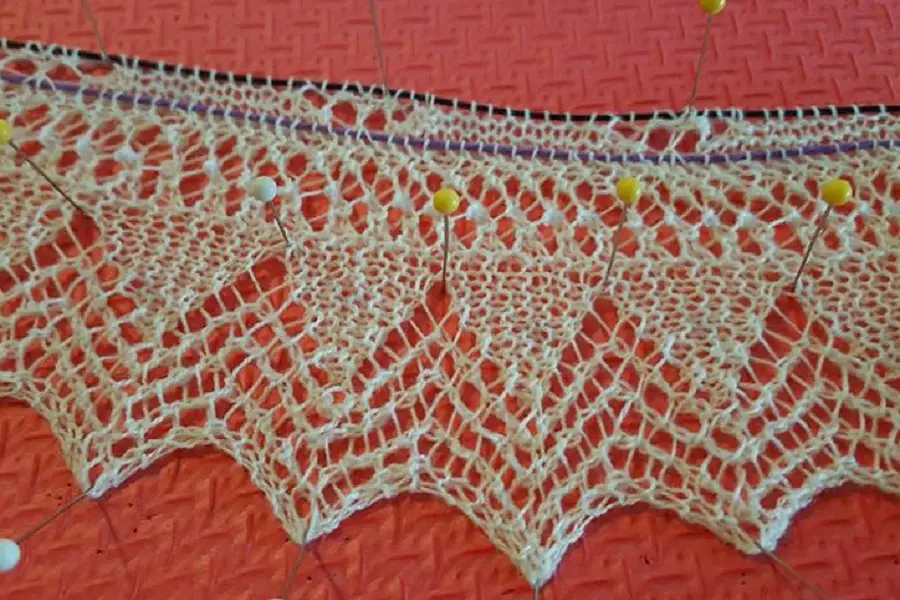Lace Knitting
Quick Links
- Archived - Ask a Knitting Question
- Basic Knitting Stitches
- Beginner Knitting Patterns
- Knitting Abbreviations
- Needle Sizes Chart
- Tension Squares
- Yarn Comparison Chart
FYI: This site receives a small amount in commissions from affiliate links and third-party advertising.
Lace knitting is a decorative form of knitting generally with fine yarn that has a pattern of 'holes' in the fabric to form a lacy pattern.
True lace is very complex and requires the knitter to really pay attention to what they are doing, every row is likely to be a pattern row unlike simple lace where the pattern row may only occur every 2nd, 4th or even 6th row with plain stocking stitch rows in between.
The patterns are created by creating new stitches by wrapping the yarn over or around the needle and decreasing the same number of stitches by knitting 2 or more stitches together.
Most true lace patterns will have a knitting chart for the row by row instructions (much easier to follow than written instructions for visual learners).
Styles of Lace Knitting
According to knitting historians, there are three main categories of true knitted lace, Shetland, Estonian and Orenburg Lace. Each type of lace has a unique style and uses a clearly defined set of stitches and stitch combinations to create complex and very beautiful lace patterns.
Shetland Lace
There are several different styles of lace knitting, because of my family background my favourite style is Shetland lace knitting. This style is characterised by very fine wool - preferably wool spun from the neck of Shetland sheep if you are a purist and patterns where all rows are knit rows.
This way there is no right or wrong side of your knitting. Both sides can be the 'right' side of your knitted fabric. Shetland lace knitting techniques are used to create beautifully fine baby shawls (that will fit through a wedding ring), wedding shawls or veils, haps and stoles and scarves.
Estonian Lace
Estonian lace is a unique kind of knitted lace. The distinguishing features of this style of lace are the stitches that are used, those stitches include knitted bumps called nupps, a flower stitch, a star stitch, and geometric motifs.
Usually, unlike a Shetland shawl, an Estonian lace shawl will have a plain purl wrong side and all lace work will be done on the right side.
Orenburg lace
Orenburg lace originated in the Orenburg region of Russia and the style of knitting was passed from from one generation to the next. As with Shetland lace knitting, Orenburg lace is usually knitted on a garter stitch base and were traditional knitted in fibres from a unique breed of goat found in the Orenburg region, which has both firm and soft down.
In Orenburg lace knitting there are ten basic stitch pattern elements which can be combined to form beautiful and sometimes complex lace designs.
Blocking Your Lace Knitting
After knitting Shetland (and Estonian) Lace is usually blocked to open up the lace pattern. Blocking involves wetting or washing the knitted piece and then pinning the finished work out flat and slightly stretched using pins (stainless steel so they do not rust and mark the wool), stainless steel blocking rods or a hap frame.
"A Hap is essentially a wrap which is used to keep you warm, of course they come in many shapes and sizes but traditional Shetland Haps are square with a centre panel, a patterned surround (usually feather and fan lace) and an edging."
The slightly stretched and damp knitting is then left somewhere safe place to dry and set the shape. Most will leave the blocked piece over night but the recommendation of most Shetland knitters is to leave your blocked knitting for 48 hours before removing it from the blocking pads or hap frame.
You do not need to spend a fortune on your 'blocking gear', rather than buying expensive blocking pads you can go to your local hardware store and buy interlocking rubber tiles instead. You can get stainless steel pins from your local craft or haberdashery store and TIG stainless steel welding rods are perfect as straight blocking wires. (I use 1.6mm 308 Stainless Steel TIG Filler Rods, I just padded each end of each rod with Polymorph mouldable plastic pellets to prevent snags - they are just under a metre long and work perfectly well for blocking straight edges).

Couldn't Find What You Were Looking for?
Try searching the site using the search box below:

Recent Articles
-
Shetland Knitting and Shetland Knitters
Feb 07, 21 07:44 AM
Shetland knitting and the women in the Shetland Isle who create Shetland lace are among the best knitters in the world. -
Fixing Knitting Mistakes
Jan 28, 21 02:35 AM
When you are learning how to knit, you are going to make a few mistakes. It might not make you happy but fixing knitting mistakes is par for the course. -
Shetland Lace Knitting
Dec 11, 19 07:03 PM
Shetland Lace Knitting is a particular style of knitting that developed in the Shetland Islands and was one of the main exports of the Island early in the last century.
 >
>



